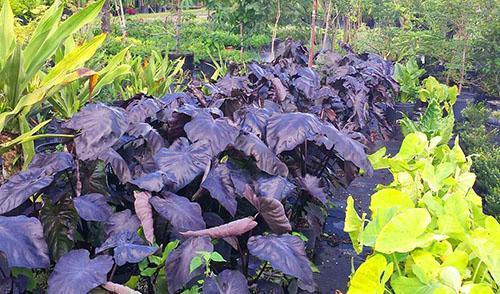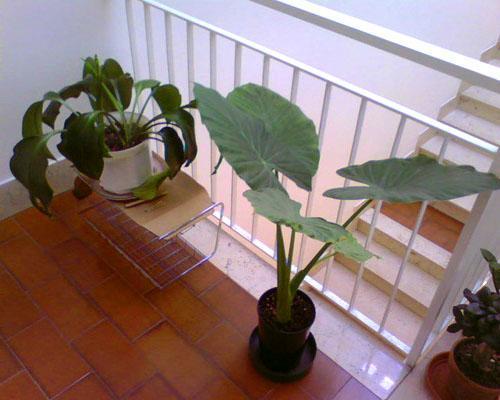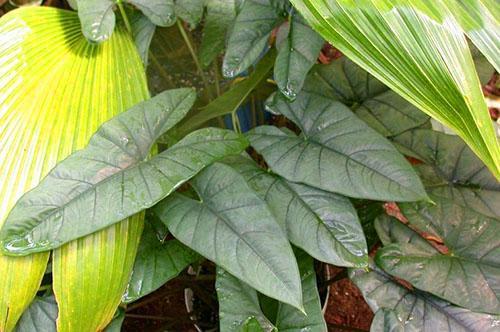Descriptions and photos of varieties and varieties of alocasia for growing at home
 The flora of tropical rainforests is so rich and diverse that it still gives botanists both surprises and reasons for serious scientific discoveries. The genus of alocasia includes several dozen species, the exact number of which is difficult to name even by a specialist in tropical flora.
The flora of tropical rainforests is so rich and diverse that it still gives botanists both surprises and reasons for serious scientific discoveries. The genus of alocasia includes several dozen species, the exact number of which is difficult to name even by a specialist in tropical flora.
And it's not just the inaccessibility of the islands of Oceania or the dense jungle that hides the specimens that have not yet been studied. The nature of the region is incredibly generous and creates all the conditions for natural hybridization and the emergence of new varieties of alocasia.

Alocasia Corazon
 From the humid tropics and subtropics of southern Asia and Australia, a spectacular, but very small indoor alocasia, as in the photo, does not exceed 40–55 cm in height, came to Europe. The variety was bred as a result of painstaking selection work, and several wild species became the parental forms.
From the humid tropics and subtropics of southern Asia and Australia, a spectacular, but very small indoor alocasia, as in the photo, does not exceed 40–55 cm in height, came to Europe. The variety was bred as a result of painstaking selection work, and several wild species became the parental forms.
The leaves, the main treasure of Corazon alocasia, are smooth, green, with a grayish metallic sheen. Dark veins are clearly visible against the background of a rather light leaf plate. The length of the leaf of this variety of alocasia, as in the photo, reaches 20 cm, the width of the plate is half as much.
Alocasia Corazon is very attractive, but for the best features of the plant, it needs bright enough, but not direct light, abundant watering and attentive care, especially aimed at pest control. The culture can infect the spider mite, which quickly colonizes the cuttings and the back of the leaves.
Unfortunately, today this variety is rarely seen on window sills. although it is no less interesting than the well-known varieties such as the Black Corduroy alocasia or the hybrid alocasia amazonica polly.
Alocasia Polly
 The Polly alocasia shown in the photo is the smallest representative of plants, thanks to the shape of the leaves that have earned the name "African mask". The height of an adult plant does not exceed 50–65 cm, which makes it possible to find a place for culture even in a small room. The only condition for good growth is an abundance of moisture, light and heat. With proper care, Alokazia Amazonica Polly is grown as a perennial crop, and this variety more easily tolerates the lack of lighting, which is inevitable in the fall-winter period.
The Polly alocasia shown in the photo is the smallest representative of plants, thanks to the shape of the leaves that have earned the name "African mask". The height of an adult plant does not exceed 50–65 cm, which makes it possible to find a place for culture even in a small room. The only condition for good growth is an abundance of moisture, light and heat. With proper care, Alokazia Amazonica Polly is grown as a perennial crop, and this variety more easily tolerates the lack of lighting, which is inevitable in the fall-winter period.
The dark, pointed foliage with contrasting veins can be compared with the shield of an ancient warrior or, as in the photo of alocasia, with a trefoil.
By its nature, Polly alocasia is a dwarf variety of Amazonica alocasia, obtained through the crossing of wild plants in the middle of the last century. The very same Polly alocasia shown in the photo was first grown only two decades ago and in such a short time won the love of flower growers all over the world.
Alokaziya Saryan
 The foliage shape of Alocasia Sarian is very similar to the previous plant. But if you look at the photo of alocasia varieties, it becomes clear that alocasia Saryan, compared to Polly, is a real giant.
The foliage shape of Alocasia Sarian is very similar to the previous plant. But if you look at the photo of alocasia varieties, it becomes clear that alocasia Saryan, compared to Polly, is a real giant.
The plant has large, dense leaves with a jagged curly edge and a sharp tip.White veins stand out brightly against a rich green background. The leaf plate is smooth, with a characteristic gloss.
Alocasia the Dragon
 Alocasia variety, popular among flower growers, Dragon Skin, as in the photo, attracts attention with the unusual texture of the foliage, which really resembles the scales or leathery wings of a fabulous monster.
Alocasia variety, popular among flower growers, Dragon Skin, as in the photo, attracts attention with the unusual texture of the foliage, which really resembles the scales or leathery wings of a fabulous monster.
Plant height is small and does not exceed 0.6–1 meters. The native land of the wild-growing ancestor of alocasia Dragon is the tropics of Indonesia, where copper alocasia mastered the wet undergrowth. In apartments for the plant, it is also necessary to create suitable conditions, consisting of abundant but dim light, regular watering and good nutrition. With proper care, as in the photo, Dragon scale alocasia will delight the grower for a long time.
The main decoration of the flower is the extremely large and beautiful foliage, which makes the plant unforgettable and gives it an exotic look. Alocasia rhizomes are elongated and juicy. The leaf stalks are light green, bending under the weight of the leaf blades, which eventually leads to the formation of a real "dragon skin".
 Young foliage is often green, but as it grows, as in the photo of alocasia Dragon, darker and silvery tones appear on it, giving the leaves of the plant a leathery appearance. It is the ideal plant for distinctive stylish interiors and winter gardens. In order for alocasia to retain its attractiveness for a long time, it is protected from bright light that can burn decorative foliage.
Young foliage is often green, but as it grows, as in the photo of alocasia Dragon, darker and silvery tones appear on it, giving the leaves of the plant a leathery appearance. It is the ideal plant for distinctive stylish interiors and winter gardens. In order for alocasia to retain its attractiveness for a long time, it is protected from bright light that can burn decorative foliage.
Alocasia Loco
 A photo of this room alocasia invariably causes surprise and delight for lovers of home floriculture. Medium-sized, with a glossy shine and a very sharp tip, the foliage of this variety of alocasia, as in the photo, has the shape of a pronounced trefoil, and it leaves the feeling that it is made of metal or plastic. Such an amazing plant will be a great addition to growing at home. tangerines, ficuses and other flowers.
A photo of this room alocasia invariably causes surprise and delight for lovers of home floriculture. Medium-sized, with a glossy shine and a very sharp tip, the foliage of this variety of alocasia, as in the photo, has the shape of a pronounced trefoil, and it leaves the feeling that it is made of metal or plastic. Such an amazing plant will be a great addition to growing at home. tangerines, ficuses and other flowers.
 Veins on leaf plates are white, with a blurred outline. The back of the leaves has a purple or purple hue. The edge of the leaf blade is not only figuratively cut, but also corrugated, which only adds decorativeness to the unusual culture. A plant up to 50 cm tall, worthy of being in the collection of a florist who is passionate about tropical species!
Veins on leaf plates are white, with a blurred outline. The back of the leaves has a purple or purple hue. The edge of the leaf blade is not only figuratively cut, but also corrugated, which only adds decorativeness to the unusual culture. A plant up to 50 cm tall, worthy of being in the collection of a florist who is passionate about tropical species!
Alocasia Bambino Arrow
 Small alocasia Bambino Arrow is a variety of the Amazonica hybrid species, well known to flower growers. Plants with sharp arrow-shaped leaves in indoor conditions can grow up to 40-60 cm, some dwarf varieties are limited in development at the level of 30-40 cm.
Small alocasia Bambino Arrow is a variety of the Amazonica hybrid species, well known to flower growers. Plants with sharp arrow-shaped leaves in indoor conditions can grow up to 40-60 cm, some dwarf varieties are limited in development at the level of 30-40 cm.
Indoor alocasia, as in the photo, is grown in the summer months at temperatures between 22 and 25 ° C. In winter, when a perennial evergreen plant needs relative rest, cooling the air to 18–20 ° C will not harm alocasia.
 The leaves of this variety of alocasia, as in the photo, have a dark color, on which wide white veins look impressive. Leaf petioles are erect.
The leaves of this variety of alocasia, as in the photo, have a dark color, on which wide white veins look impressive. Leaf petioles are erect.
Alocasia Bambino Arrow requires well-drained soil, adequate nutrition and abundant watering for good growth and development. The plant is transplanted after a year. The procedure is best done in the spring, at the beginning of the growing season.
Alocasia macrorrhiza Lutea
 The name of the variety of alocasia Lutea shown in the photo is translated from Latin as "yellow", which fully reflects the main feature of the plant. Juicy thick cuttings of leaves, parts of the stem and even veins on the leaves have a clear yellow tint. This gives the large alocasia additional attractiveness and distinguishes it from similar species and varieties.
The name of the variety of alocasia Lutea shown in the photo is translated from Latin as "yellow", which fully reflects the main feature of the plant. Juicy thick cuttings of leaves, parts of the stem and even veins on the leaves have a clear yellow tint. This gives the large alocasia additional attractiveness and distinguishes it from similar species and varieties.
The plant has large, wavy leaves of a bright green color. The leaf plate of a native of the forests of New Guinea reaches 60 cm in length, and the alocasia itself grows up to one and a half meters. Such sizes and shapes of foliage fully justify the popular name of this type of plants - elephant ears.
Alocasia Black Corduroy
 The velvety leaves of alocasia Black Velvet, at the first glance at the plant, amaze everyone who is fond of indoor floriculture.The upper side of the leaf plate of this variety is distinguished not only by an unusual texture for alocasia, but also by a rich, almost black shade, which gave the plant its name.
The velvety leaves of alocasia Black Velvet, at the first glance at the plant, amaze everyone who is fond of indoor floriculture.The upper side of the leaf plate of this variety is distinguished not only by an unusual texture for alocasia, but also by a rich, almost black shade, which gave the plant its name.
Thick white veins are perfectly visible against the velvet background. The stems are also light, erect or slightly sloping. Indoors, alocasia grows up to 30–45 cm in height, which makes the culture very attractive to most gardeners.
 This exotic plant can become a unique interior decoration and create a corner of tropical Asia and Oceania in a city apartment.
This exotic plant can become a unique interior decoration and create a corner of tropical Asia and Oceania in a city apartment.
True, at the same time, Black Velvet alocasia, as in the photo, requires the same conditions that surrounded him at home. This means that humidity and air temperature are important to the plant. Alocasia needs a nutritious loose soil and abundant regular watering for the health and appearance of alocasia. With a careless attitude to care, alocasia quickly loses its attractiveness, its oval large leaves lose their velvety, thinner and become covered with painful spots.
In the pictured Alokazia Black Velvet, the leaves underneath are pink or purple in color with an unusual green tint. In culture, in addition to plants with ordinary rounded-oval leaves, varieties with elongated leaf platinum can be found. Usually these plants are larger and have a moderate growth rate.
Alokazia Elaine
 The cultivar Alocasia nebula Elaine is well known to growers for its unusual tough leaves of the plant, which have not only curly outlines and concave veins, but also an amazing metallic shade. The veins are blue or purple, the back of the leaf is purple.
The cultivar Alocasia nebula Elaine is well known to growers for its unusual tough leaves of the plant, which have not only curly outlines and concave veins, but also an amazing metallic shade. The veins are blue or purple, the back of the leaf is purple.
The steel-gray leaves characteristic of Elaine's alocasia take on this appearance only in adulthood. Young foliage is easily recognizable by its light green tint and softer leaf blade.
The alocasia variety, as in the photo, does not differ in its large size, which is a clear advantage for many growers.
Alocasia Black Magic
 Alocasia Black Magic, belonging to the infernalis species and arousing genuine interest in exotic plant lovers, has recently begun to replenish home collections. the name of the species means "hellish", which is fully explained by the appearance of the plant and the color of its dark purple foliage.
Alocasia Black Magic, belonging to the infernalis species and arousing genuine interest in exotic plant lovers, has recently begun to replenish home collections. the name of the species means "hellish", which is fully explained by the appearance of the plant and the color of its dark purple foliage.
You can see the wild growing Black Magic alocasia by traveling through the rainforests of Borneo, Malaysia and other regions of Southeast Asia. Local peoples call the plant “skeleton” because of the bright streaks and spots on the dark leaf.
 Indeed, the plant is very unusual! It has dark leaves with clearly outlined concave veins, as if shimmering with reddish and purple hues. The height of this room alocasia, as in the photo, usually ranges from 40 to 50 cm.
Indeed, the plant is very unusual! It has dark leaves with clearly outlined concave veins, as if shimmering with reddish and purple hues. The height of this room alocasia, as in the photo, usually ranges from 40 to 50 cm.
Interestingly, the perianth, in other varieties and species, is usually white, cream or greenish, in Black Magic alocasia is also painted in burgundy, purple or green-black.
Hello! Please answer me this question. Alocasia (I do not know the Latin name) medicinal trefoil, grows up to 50 ... 70 cm in height. A palm-wide sheet. Reproduces as usual. If you have one and can sell it, I will gladly buy it. And if there is no one, then maybe you can tell me its Latin name ... Thank you in advance for your answer. Regards to you Love
The healing type, on the basis of which various medicinal preparations are made, is called Alokasia macrorhiza. Look in flower shops or the market - these plants are often sold by hand. We are not in the business of selling.
Hello! I am very, very grateful to you for your attention and response! I still cannot find this type of alocasia, once upon a time I had it and used it for treatment. And, of course, it's a shame that you are not selling. Thank you again.and now I will at least know what to look for. All the best ! Regards Love
I cannot find a variety of alocasia in which the leaves are like saucers wide and bent upwards.